Special Report
Cities With the Worst Unemployment Since the Pandemic Started
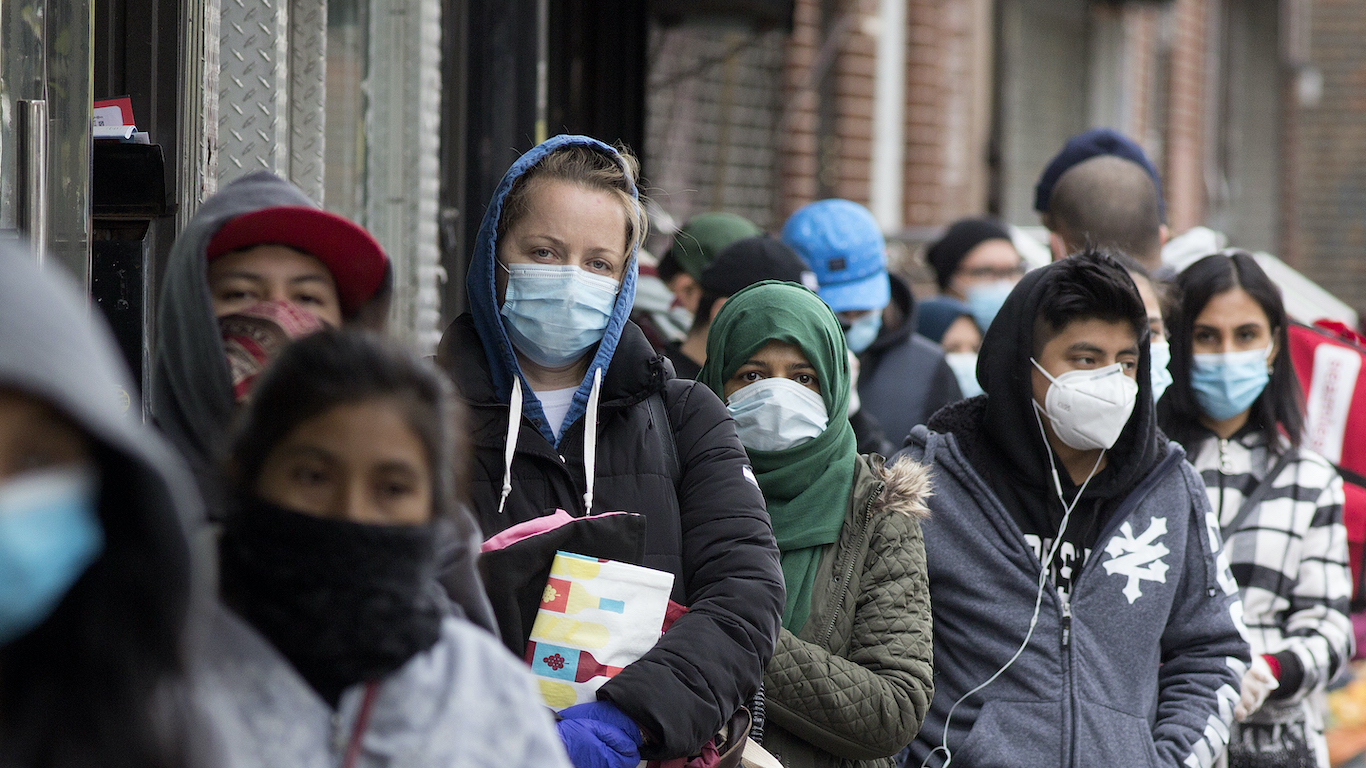
Published:

The decade since the end of the Great Recession in 2009 was one of historic economic growth in the United States. Over that period, the U.S. economy added about 20 million jobs and the unemployment rate hit its lowest level in decades. Then the COVID-19 pandemic hit, sending the economy into a new recession and cancelling out nearly all of the employment gains of the last 10 years in a matter of months.
The unemployment rate in the United States stood at 11.1% as of June. While this is a marked improvement from the 14.7% jobless rate in April, it is still higher than at any time in at least the last 70 years. In some U.S. cities — many of which are major economic hubs — the unemployment crisis is far worse than it is nationwide.
24/7 Wall St. reviewed seasonally adjusted unemployment rates from the Bureau of Labor Statistics at the metropolitan area level to identify the cities with the worst unemployment problem. Each of the 33 metro areas on this list has a jobless rate over 15%.
All else being equal, the severity of the consequences of unemployment for the 17.8 million Americans who are out of work varies, depending on where they live. Some parts of the country have relatively strong social safety nets, providing residents who are out of work access to a range of benefits with few restrictions. Here is a look at the worst states in which to be unemployed.
The economic crisis is the result of the COVID-19 pandemic — a major public health crisis. There have been nearly 5 million confirmed COVID-19 cases in the United States to date, including over 160,000 deaths attributed to the virus. In addition to soaring unemployment, many of the metro areas on this list are disproportionately affected by a high concentration of cases of the coronavirus. Here is a look at the cities where COVID-19 is growing the fastest.
Click here to see the cities with the worst unemployment since the pandemic started
Click here to read our methodology

33. Battle Creek, MI
> Unemployment rate, June 2020: 15.1%
> Year-to-date employment change: -8.7%
> Cumulative COVID-19 cases to date: 699 (520 per 100,000 people)
> Poverty rate: 18.0%
> Population: 134,487
Battle Creek, Michigan, is one of 33 U.S. metro areas where the unemployment rate stands at over 15%. Much of Battle Creek’s current employment crisis is a product of the COVID-19 crisis. At the beginning of the year, unemployment stood at just 3.9% in the southern Michigan metro area. Since January, more than 5,000 jobs have disappeared in the city, nearly one in every 10.
While Battle Creek has one of the worst unemployment crises in the country, the metro area’s job market appears to be improving. As recently as April, 25.6% of the metro area labor force was unemployed.
[in-text-ad]
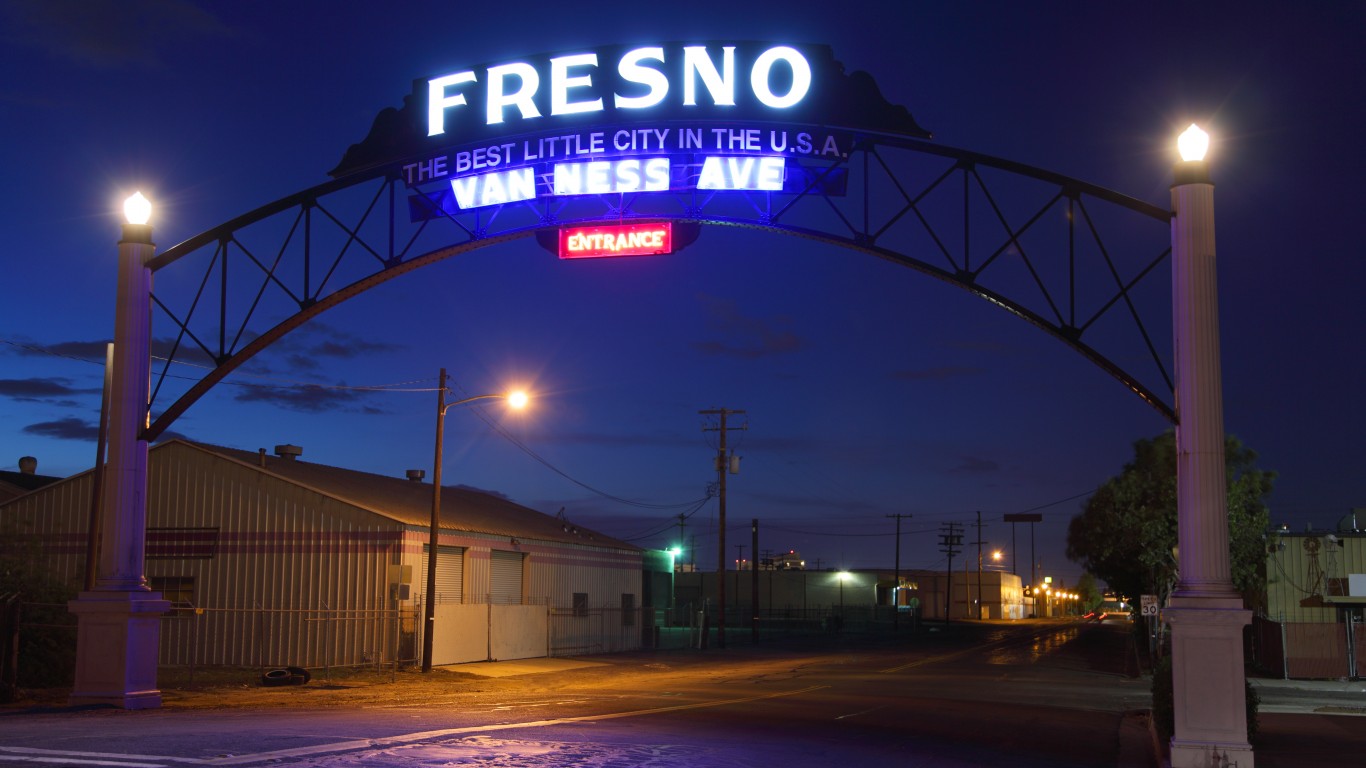
32. Fresno, CA
> Unemployment rate, June 2020: 15.1%
> Year-to-date employment change: -9.7%
> Cumulative COVID-19 cases to date: 13,209 (1,350 per 100,000 people)
> Poverty rate: 21.5%
> Population: 994,400
At the beginning of the year, before the effects of the COVID-19 pandemic were felt in the United States, Fresno had one of the worst job markets in the country. The metro area’s January 2020 jobless rate was 6.9%, nearly double the comparable 3.6% national jobless rate. Over the months since, nearly 41,000 jobs in the metro area have disappeared, and the unemployment rate now stands at 15.1%, one of the highest of any U.S. metro area.
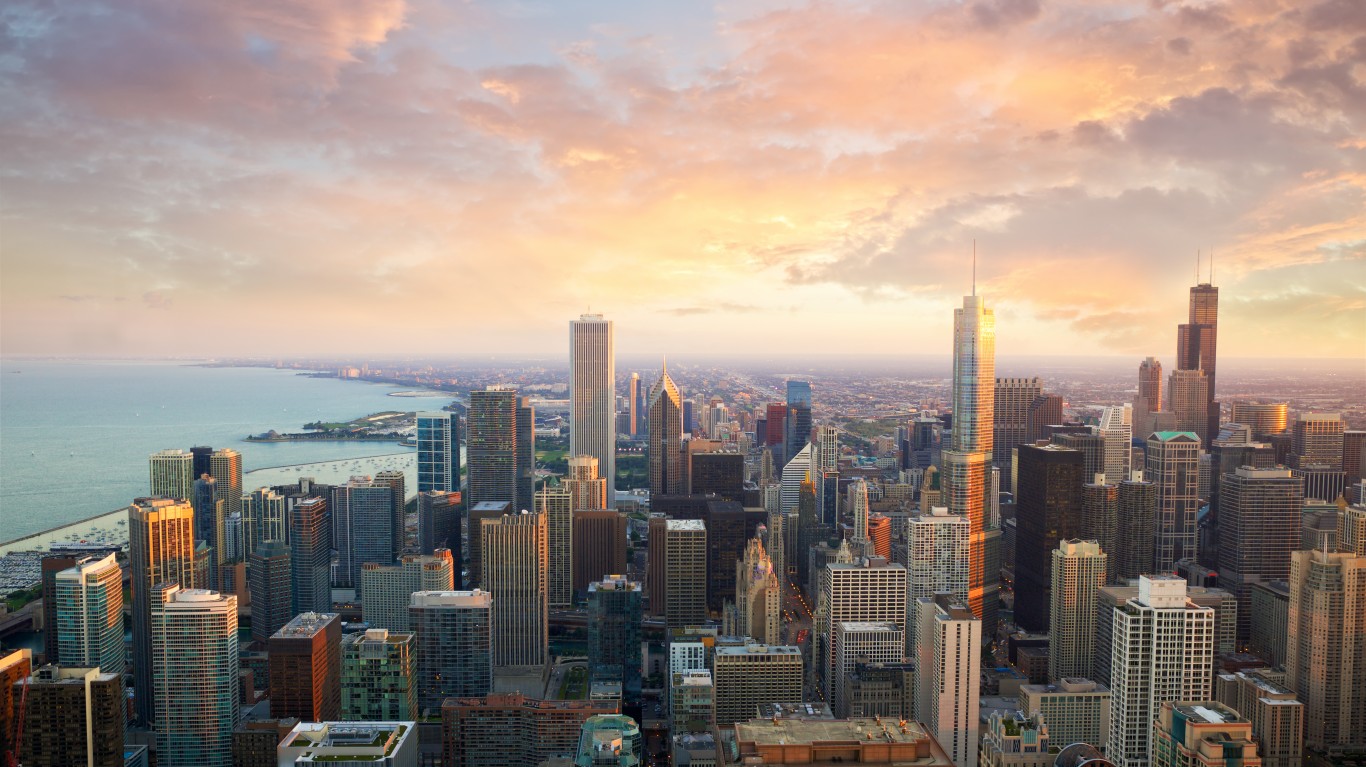
31. Chicago-Naperville-Elgin, IL-IN-WI
> Unemployment rate, June 2020: 15.2%
> Year-to-date employment change: -10.6%
> Cumulative COVID-19 cases to date: 157,746 (1,654 per 100,000 people)
> Poverty rate: 11.2%
> Population: 9.5 million
Chicago is one several major American economic hubs, and one of many Midwestern metro areas, where the unemployment rate now stands at over 15%. In January 2020, before the effects of the COVID-19 pandemic were felt in the U.S., Chicago’s unemployment rate was just 3.5%. Over the months since, the city has shed nearly half a million jobs.
As is the case in many other metropolitan areas on this list, Chicago was seriously affected by COVID-19. As of late July, there were 1,654 COVID-19 cases in Chicago for every 100,000 people, more than the 1,309 per 100,000 national concentration.

30. Modesto, CA
> Unemployment rate, June 2020: 15.2%
> Year-to-date employment change: -13.8%
> Cumulative COVID-19 cases to date: 8,228 (1,526 per 100,000 people)
> Poverty rate: 15.6%
> Population: 549,815
Modesto is one of several California metro areas with an unemployment rate above 15%. The city has shed nearly 32,000 jobs since the beginning of the year, a 13.8% overall decline in employment.
In addition to staggering job losses during the pandemic, Modesto has also had a relatively high concentration of cases of the virus itself. As of late July, there were 1,526 cases of the novel coronavirus in Modesto for every 100,000 people, more than the 1,309 per 100,000 national concentration.
[in-text-ad-2]

29. Scranton–Wilkes-Barre–Hazleton, PA
> Unemployment rate, June 2020: 15.2%
> Year-to-date employment change: -14.9%
> Cumulative COVID-19 cases to date: 5,072 (911 per 100,000 people)
> Poverty rate: 14.3%
> Population: 555,485
Scranton, one of two Pennsylvania metro areas with an unemployment rate above 15%, has been economically affected by the COVID-19 pandemic more than most American cities. Before COVID-19 was widespread in the U.S., more than one-fifth of the metro area’s workforce was employed in industries, such as transportation and warehousing, that are at a disproportionately high risk of slowdown in a pandemic scenario. Over 39,000 jobs have disappeared in the Scranton metro area since the beginning of 2020.
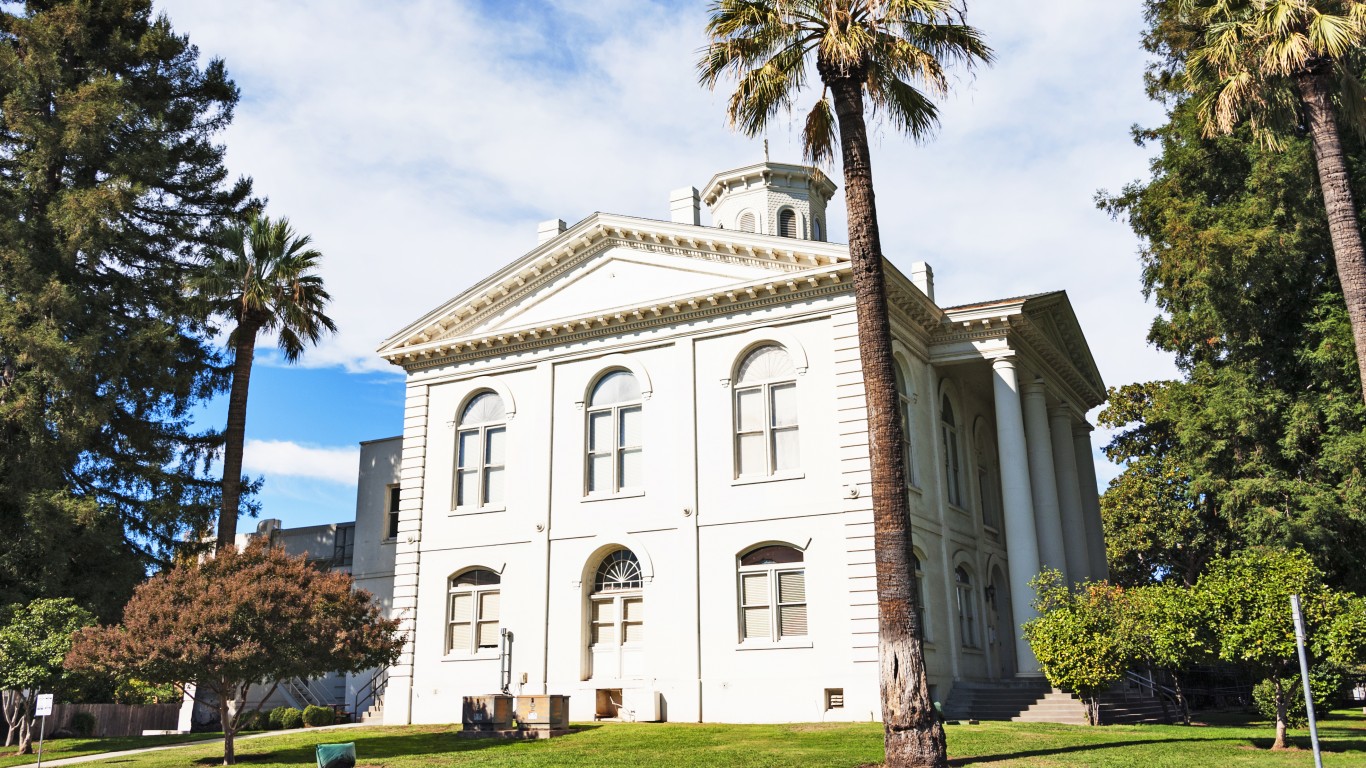
28. Yuba City, CA
> Unemployment rate, June 2020: 15.2%
> Year-to-date employment change: -17.4%
> Cumulative COVID-19 cases to date: 925 (540 per 100,000 people)
> Poverty rate: 15.1%
> Population: 174,848
About one in every six jobs that existed in Yuba City at the beginning of the year have now disappeared. Over the same period, the metro area’s unemployment rate jumped from 6.5% to 15.2%.
Americans with no education beyond high school are nearly twice as likely to be unemployed as those with a bachelor’s degree. In Yuba City, only 18.0% of the adult population has a bachelor’s degree, compared to 32.6% of American adults nationwide.
[in-text-ad]
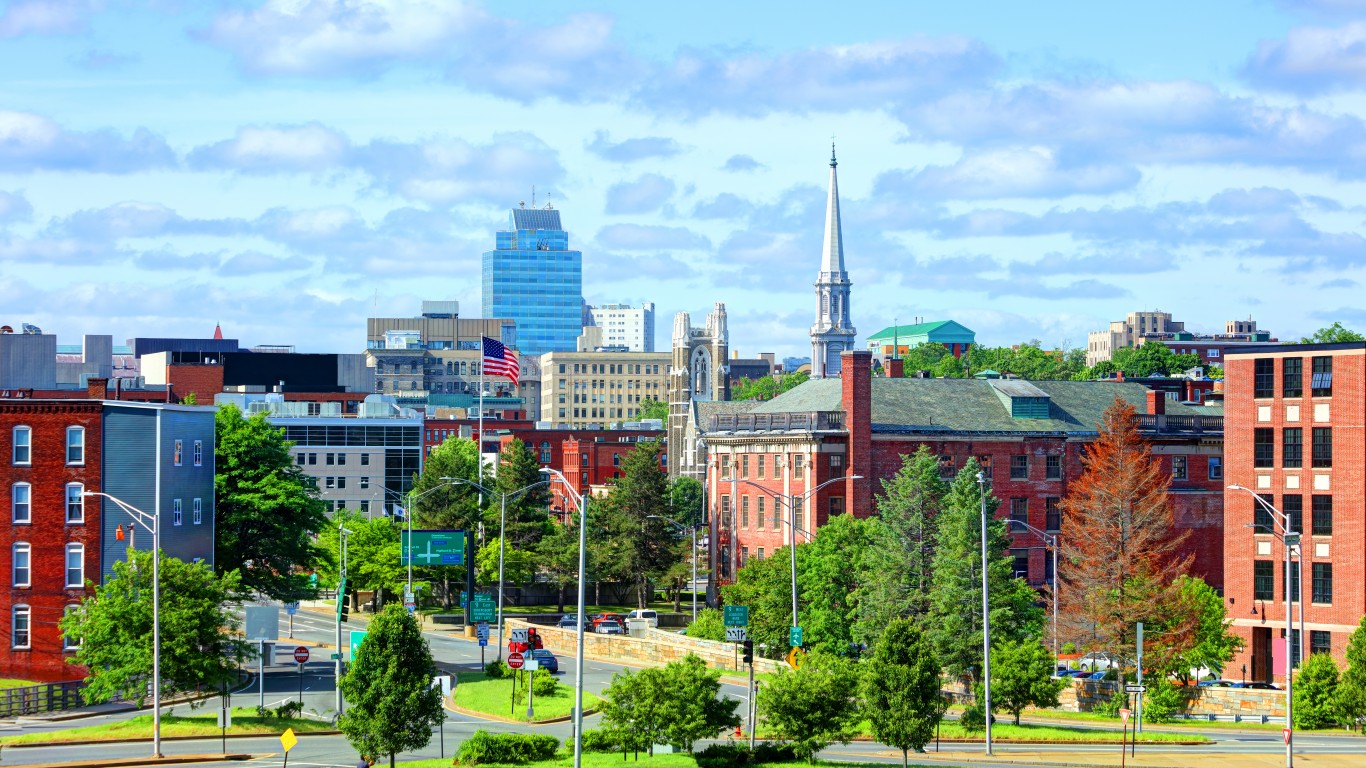
27. Worcester, MA-CT
> Unemployment rate, June 2020: 15.5%
> Year-to-date employment change: -15.7%
> Cumulative COVID-19 cases to date: 13,808 (1,471 per 100,000 people)
> Poverty rate: 9.3%
> Population: 947,866
The Worcester, Massachusetts, metro area, which includes parts of Connecticut, has an unemployment rate of 15.5% — well above the 11.1% national jobless rate. The metro area is one of several in Massachusetts with an economy that has been hit hard by the COVID-19 pandemic. Since January, Worcester has shed over 55,000 jobs.
COVID-19 has also taken a considerable toll on public health in Worcester. As of late July, there were 1,471 cases for every 100,000 people in the area, compared to 1,309 cases per 100,000 people nationwide.
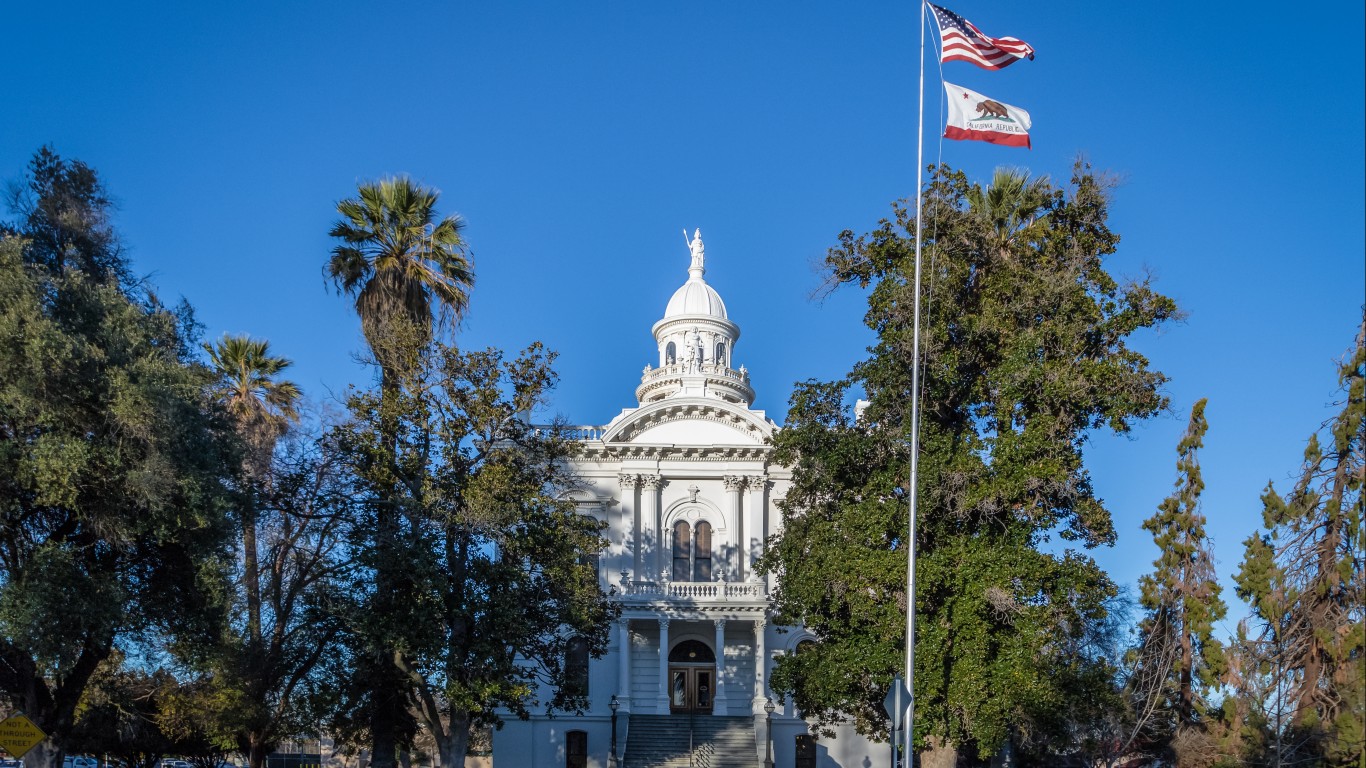
26. Merced, CA
> Unemployment rate, June 2020: 15.9%
> Year-to-date employment change: -10.1%
> Cumulative COVID-19 cases to date: 3,251 (1,208 per 100,000 people)
> Poverty rate: 22.0%
> Population: 274,765
With an unemployment rate of 15.9%, the Merced, California, metro area has one of the worst job markets in the United States. Though the city has shed more than 10,000 jobs since January, largely due to the COVID-19 pandemic, unemployment has been higher than average in the city long before the novel coronavirus hit the U.S. At the beginning of the year, 7.8% of the local labor force was unemployed, more than double the 3.6% national jobless rate at the time.
The widespread unemployment in Merced is causing further economic harm to residents of a metro area that was already characterized with high poverty. In Merced, 22.0% of the population lives below the poverty line, compared to 13.1% of Americans nationwide.
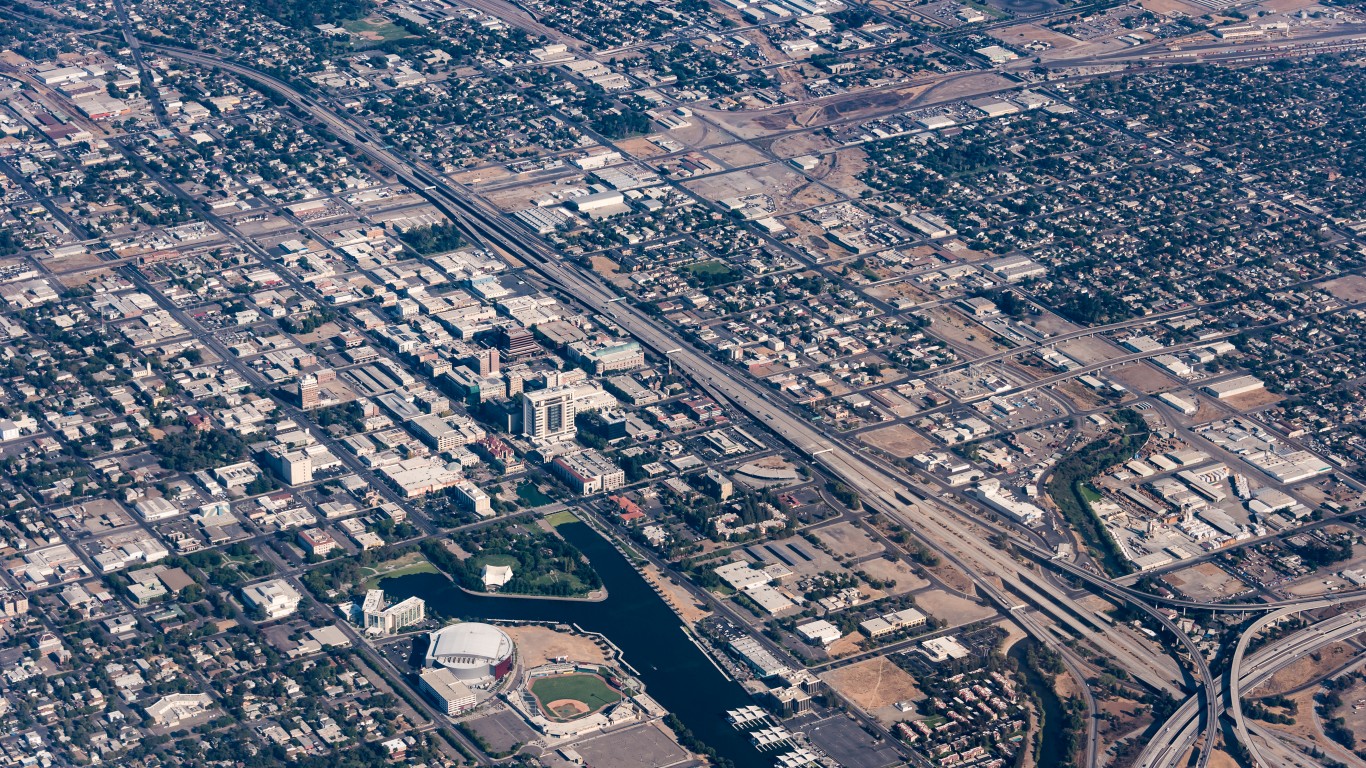
25. Stockton-Lodi, CA
> Unemployment rate, June 2020: 15.9%
> Year-to-date employment change: -11.0%
> Cumulative COVID-19 cases to date: 10,637 (1,453 per 100,000 people)
> Poverty rate: 14.2%
> Population: 752,660
In the Stockton-Lodi metro areas, industries at high-risk of slowdown during the COVID-19 pandemic, such as transportation and warehousing and tourism, account for a far higher than typical share of total employment. Partially as a result, about 34,000 jobs in the metro area — or more than one in every 10 — have disappeared so far this year. The unemployment rate in the Stockton-Lodi metro area now stands at 15.9%, up from 5.7% in January.
[in-text-ad-2]
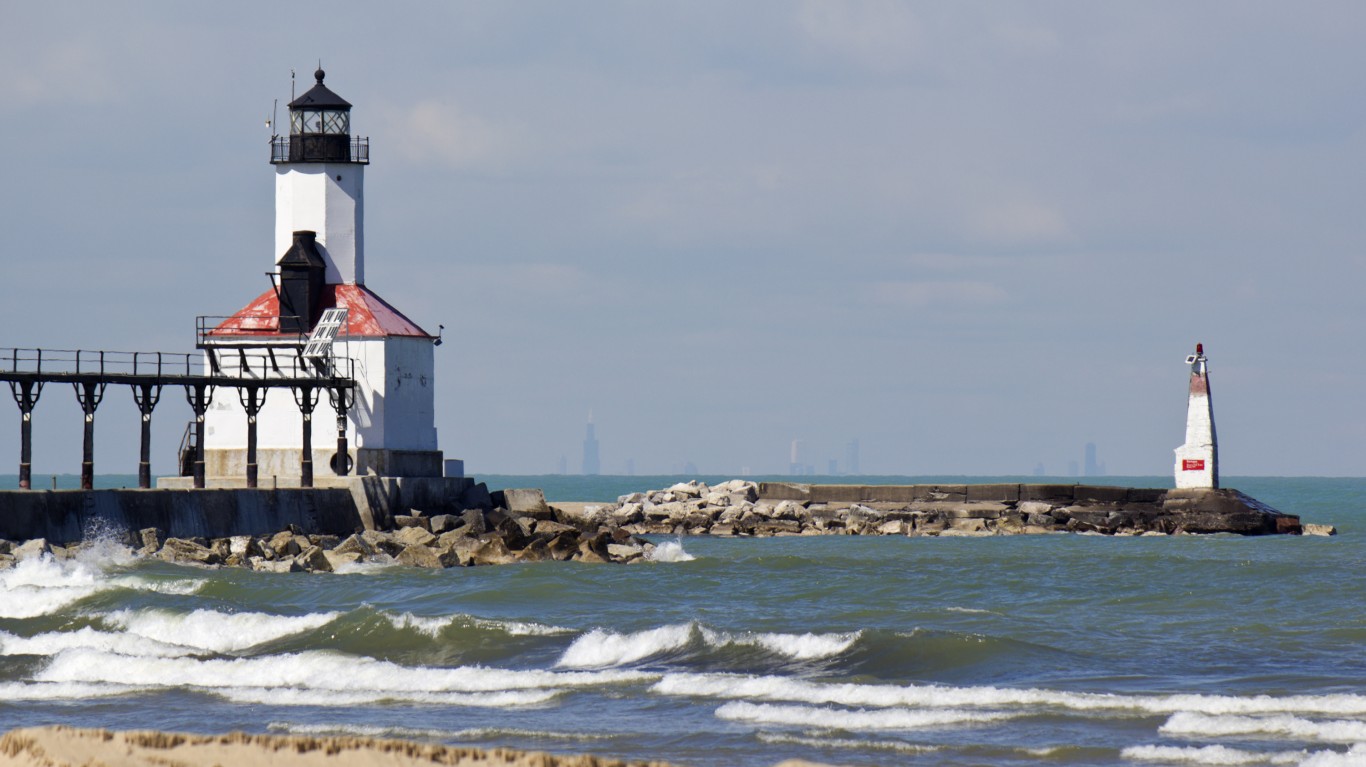
24. Michigan City-La Porte, IN
> Unemployment rate, June 2020: 16.1%
> Year-to-date employment change: -7.3%
> Cumulative COVID-19 cases to date: 760 (687 per 100,000 people)
> Poverty rate: 16.4%
> Population: 110,007
Michigan City-La Porte is one of two Indiana metropolitan areas to rank on this list. It is one of only 24 U.S. metro areas where over 16% of the labor force is unemployed. As recently as January, before the COVID-19 pandemic’s effects were felt in the United States, unemployment in the northern Indiana metro area stood at 4.0%. Currently, there are about 3,400 fewer jobs in the metro area than there were at the beginning of the year.
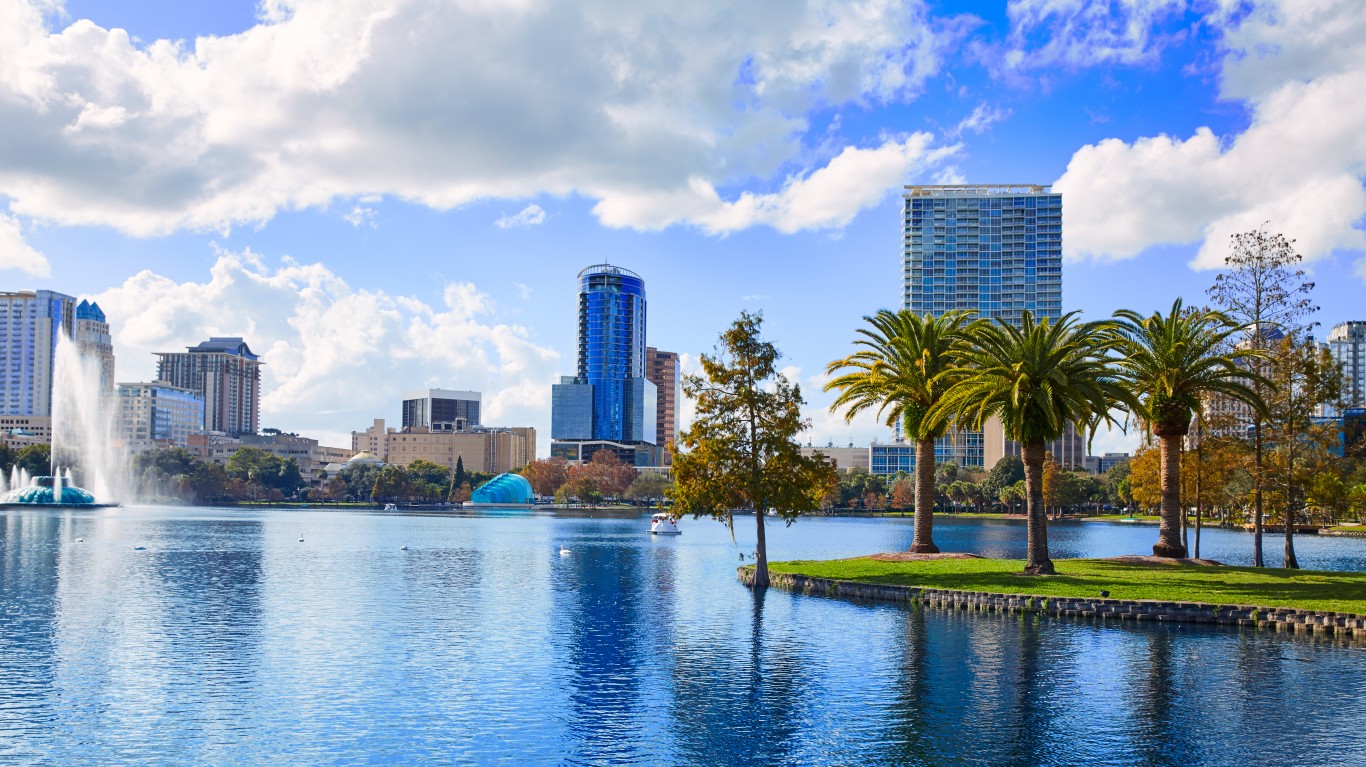
23. Orlando-Kissimmee-Sanford, FL
> Unemployment rate, June 2020: 16.4%
> Year-to-date employment change: -19.6%
> Cumulative COVID-19 cases to date: 45,406 (1,853 per 100,000 people)
> Poverty rate: 13.9%
> Population: 2.6 million
Few industries have been hit as hard by the COVID-19 recession as tourism. Home to several theme parks, including Walt Disney World and Universal Studios, Orlando’s economy depends on tourism. The number of people working in the metro area has fallen by nearly 20% since the beginning of the year. Currently, the jobless rate in the metropolitan area stands at 16.4%, well above the 11.1% national rate. After being closed for more than three months, Disney World reopened in July.
[in-text-ad]

22. Salinas, CA
> Unemployment rate, June 2020: 16.5%
> Year-to-date employment change: -22.1%
> Cumulative COVID-19 cases to date: 3,901 (900 per 100,000 people)
> Poverty rate: 13.4%
> Population: 435,594
Salinas is one of 10 California metro areas to rank on this list. Since January, more than one in every five jobs have disappeared in Salinas. Over the same period, the metro area’s jobless rate nearly tripled from 5.8% to 16.5%.
As is the case in much of the country — even in many metro areas on this list — Salinas’ current unemployment rate represents an improvement from the earliest months of the pandemic. The jobless rate in Salinas stood at 20.0% as recently as April.
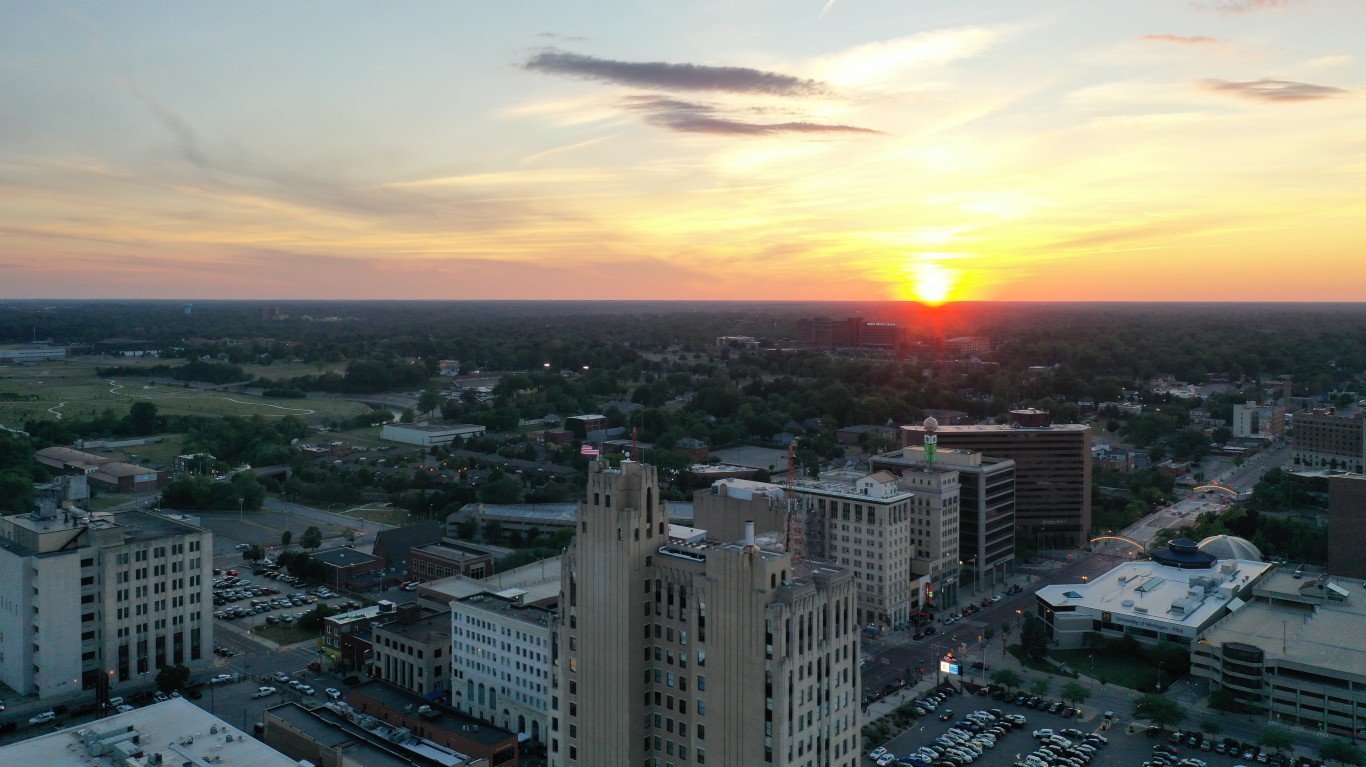
21. Flint, MI
> Unemployment rate, June 2020: 16.6%
> Year-to-date employment change: -8.2%
> Cumulative COVID-19 cases to date: 3,327 (813 per 100,000 people)
> Poverty rate: 18.8%
> Population: 406,892
Flint, Michigan is one of many poor American cities where unemployment has been soaring since the COVID-19 pandemic reached the U.S. The number of people working in the Flint metro area fell by 8.2% from January 2020 through June 2020. The metro area’s unemployment rate now stands at 16.6%, higher than in all but 20 other U.S. metro areas.
While the pandemic has contributed to thousands of job losses in Flint this year, the metro area’s job market was not especially strong going into 2020. Flint’s January unemployment rate of 4.6% was well above the 3.6% national rate.
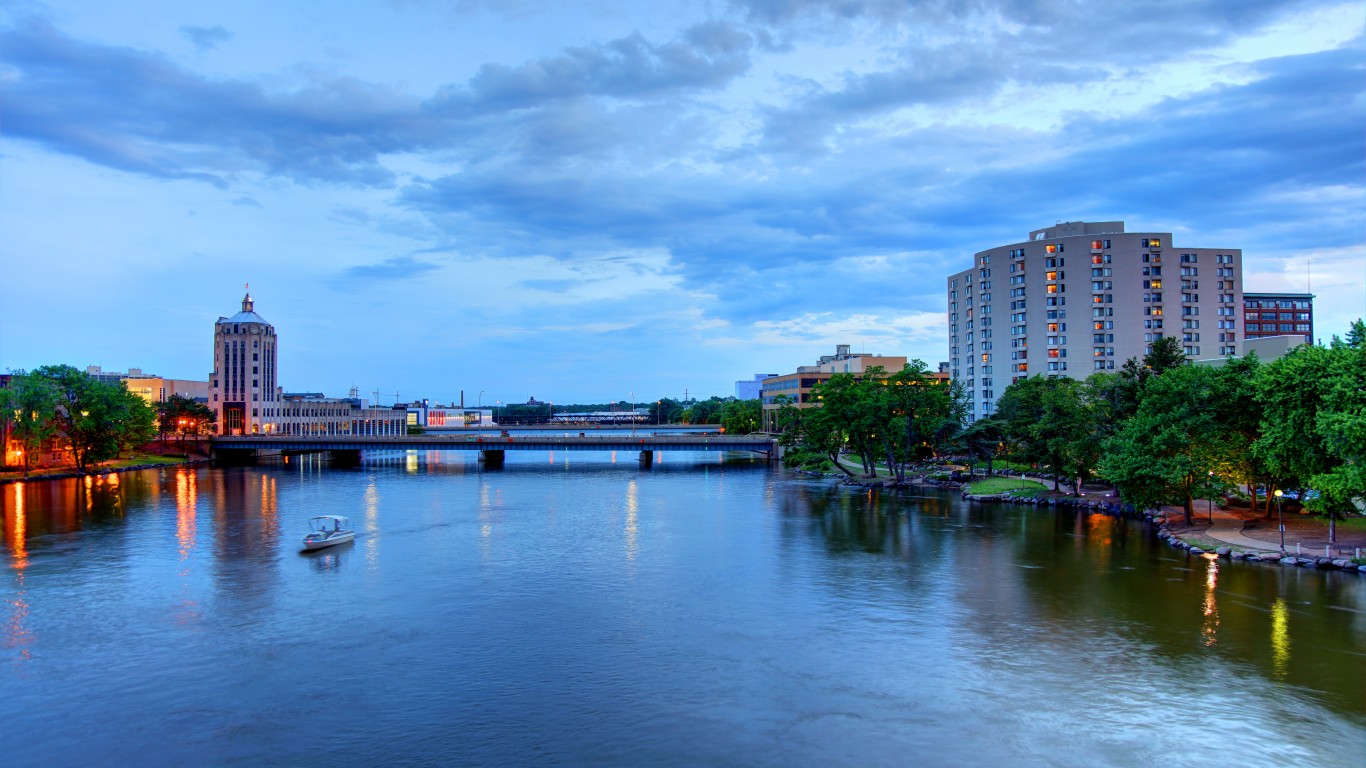
20. Rockford, IL
> Unemployment rate, June 2020: 16.7%
> Year-to-date employment change: -11.2%
> Cumulative COVID-19 cases to date: 4,234 (1,246 per 100,000 people)
> Poverty rate: 15.8%
> Population: 337,658
The 16.7% unemployment rate in Rockford, Illinois, is among the highest of any U.S. metro area. Still, the metro area’s jobless rate is a marked improvement from what it was in the early weeks of the pandemic. As recently as April, the unemployment rate in Rockford stood at a staggering 23.7%.
While the improvement in recent months is encouraging, the metro area’s job market has a long way to go. More than one in every 10 jobs that existed in Rockford at the beginning of January have disappeared.
[in-text-ad-2]

19. Boston-Cambridge-Newton, MA-NH
> Unemployment rate, June 2020: 16.7%
> Year-to-date employment change: -18.3%
> Cumulative COVID-19 cases to date: 84,214 (1,750 per 100,000 people)
> Poverty rate: 9.2%
> Population: 4.9 million
The Northeastern United States has been hit especially hard by the COVID-19 pandemic — and economies across the region have also been taking a hit. In Boston, the largest metro area in New England, 16.7% of the labor force is out of work, one of the highest unemployment rates of any U.S. metro area. In January 2020, before COVID-19 had hit most of the country, there were about 2.8 million people working in the Boston metro area. As of June, there were only 2.3 million workers — an 18.3% decline.

18. Springfield, MA
> Unemployment rate, June 2020: 16.7%
> Year-to-date employment change: -18.4%
> Cumulative COVID-19 cases to date: 8,800 (1,255 per 100,000 people)
> Poverty rate: 15.4%
> Population: 631,761
Massachusetts is one of the hardest hit states by the COVID-19 pandemic — both in terms of public health and economic consequences. In Springfield, one of several metro areas in the state to rank on this list, the number of people working has declined by a staggering 18.4%. As of June, the unemployment rate in Springfield stood at 16.7%, compared to the 11.1% national jobless rate.
The widespread unemployment in Springfield is causing considerable economic harm to residents of a metro area where financial hardship was relatively common to begin with. In Springfield, 15.4% of the population lives below the poverty line, compared to 13.1% of Americans nationwide.
[in-text-ad]

17. Kokomo, IN
> Unemployment rate, June 2020: 17.1%
> Year-to-date employment change: -9.6%
> Cumulative COVID-19 cases to date: 751 (912 per 100,000 people)
> Poverty rate: 11.2%
> Population: 82,366
Kokomo is one of only 17 U.S. metro areas with an unemployment rate over 17%. Still, the metro area’s job market has improved substantially in recent months. As recently as April, the area’s unemployment rate was 33.8%, making the city one of only four nationwide where more than one in every three members of the labor force were unemployed.
The job market in the Kokomo metro area still has a long way to recover. In June of 2019, just 3.7% of workers in the area were unemployed.

16. New York-Newark-Jersey City, NY-NJ-PA
> Unemployment rate, June 2020: 17.1%
> Year-to-date employment change: -15.5%
> Cumulative COVID-19 cases to date: 506,636 (2,623 per 100,000 people)
> Poverty rate: 12.3%
> Population: 20.0 million
New York City was long considered the epicenter of the COVID-19 pandemic in the United States. Across the broader New York metro area, there have been over half a million confirmed cases of the novel coronavirus, or 2,623 for every 100,000 people, more than double the concentration nationwide.
The broader New York metropolitan area has also taken a harder hit economically than most of the country. Unemployment in the metro area stands at 17.1%, compared to the 11.1% national jobless rate. At the beginning of 2020, the unemployment rate in New York was just 3.6%.
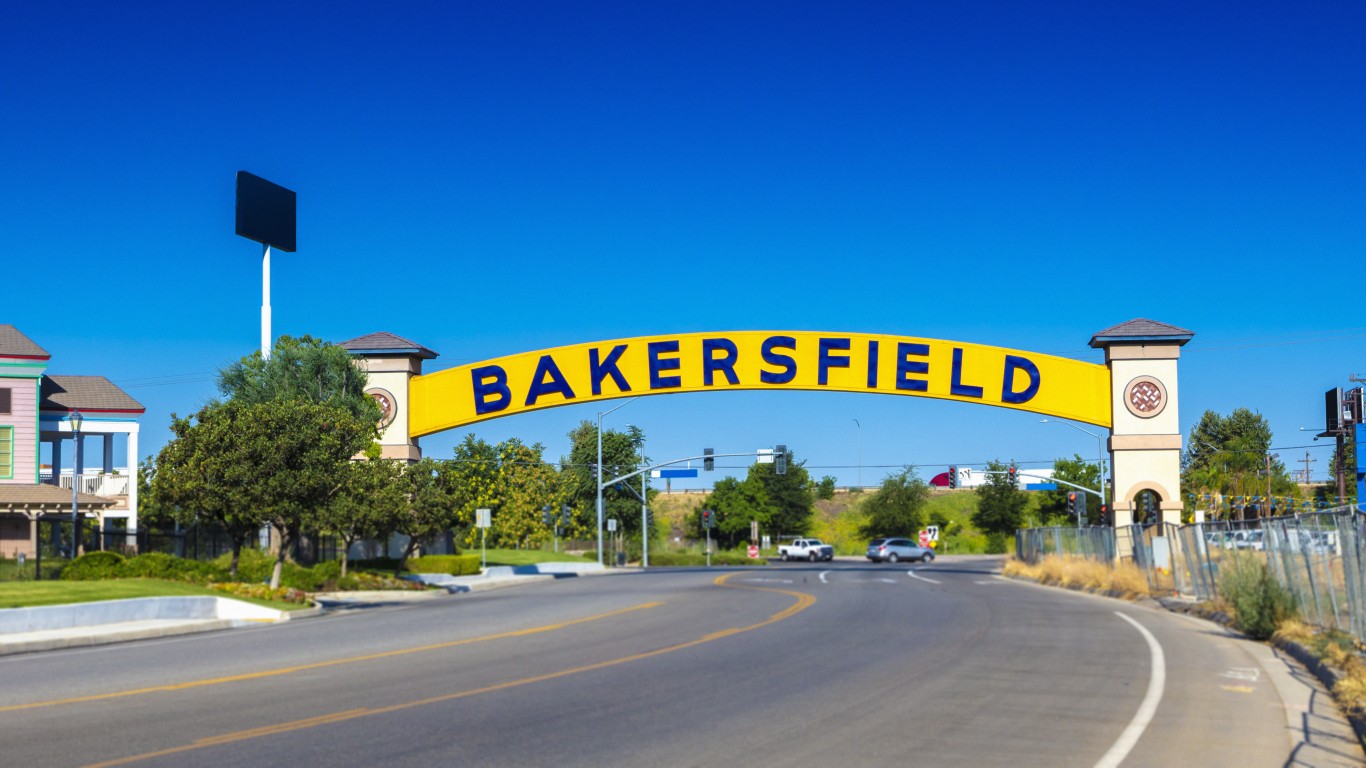
15. Bakersfield, CA
> Unemployment rate, June 2020: 17.4%
> Year-to-date employment change: -15.4%
> Cumulative COVID-19 cases to date: 17,394 (1,970 per 100,000 people)
> Poverty rate: 20.6%
> Population: 896,764
There are 56,000 fewer people working in Bakersfield now than there were at the beginning of 2020. Mass layoffs, spurred by the COVID-19 pandemic, drove the local unemployment rate up from 7.4% in January to 17.4% in June.
Bakersfield ‘s widespread unemployment is causing considerable economic harm to residents of a metro area where financial hardship was relatively common to begin with. In Bakersfield, 20.6% of the population lives below the poverty line, compared to 13.1% of Americans nationwide.
[in-text-ad-2]

14. Vineland-Bridgeton, NJ
> Unemployment rate, June 2020: 17.5%
> Year-to-date employment change: -12.6%
> Cumulative COVID-19 cases to date: 3,144 (2,050 per 100,000 people)
> Poverty rate: 14.6%
> Population: 150,972
Many of the U.S. cities that have experienced soaring unemployment as a result of the pandemic are located in New Jersey. One of them is Vineland-Bridgeton, where 17.5% of the labor force is unemployed. Since January, nearly 8,000 jobs in the metro area have disappeared.
Like much of the Northeast, the Vineland-Bridgeton has had an especially high concentration of the novel coronavirus. There have been 2,050 cases of COVID-19 for every 100,000 people to date, well above the 1,309 cases per 100,000 people nationwide.

13. Los Angeles-Long Beach-Anaheim, CA
> Unemployment rate, June 2020: 17.6%
> Year-to-date employment change: -18.1%
> Cumulative COVID-19 cases to date: 208,674 (1,573 per 100,000 people)
> Poverty rate: 13.3%
> Population: 13.3 million
Along with places like Boston, Chicago, Detroit, and New York, Los Angeles is one of several major American metro areas with especially high unemployment during the COVID-19 pandemic. As of June, 17.6% of the LA metro area’s labor force was out of work, well above the 11.1% national jobless rate. The number of people working in the metro area now stands at around 5.3 million, down 18.1% from 6.5 million at the beginning of 2020.
[in-text-ad]
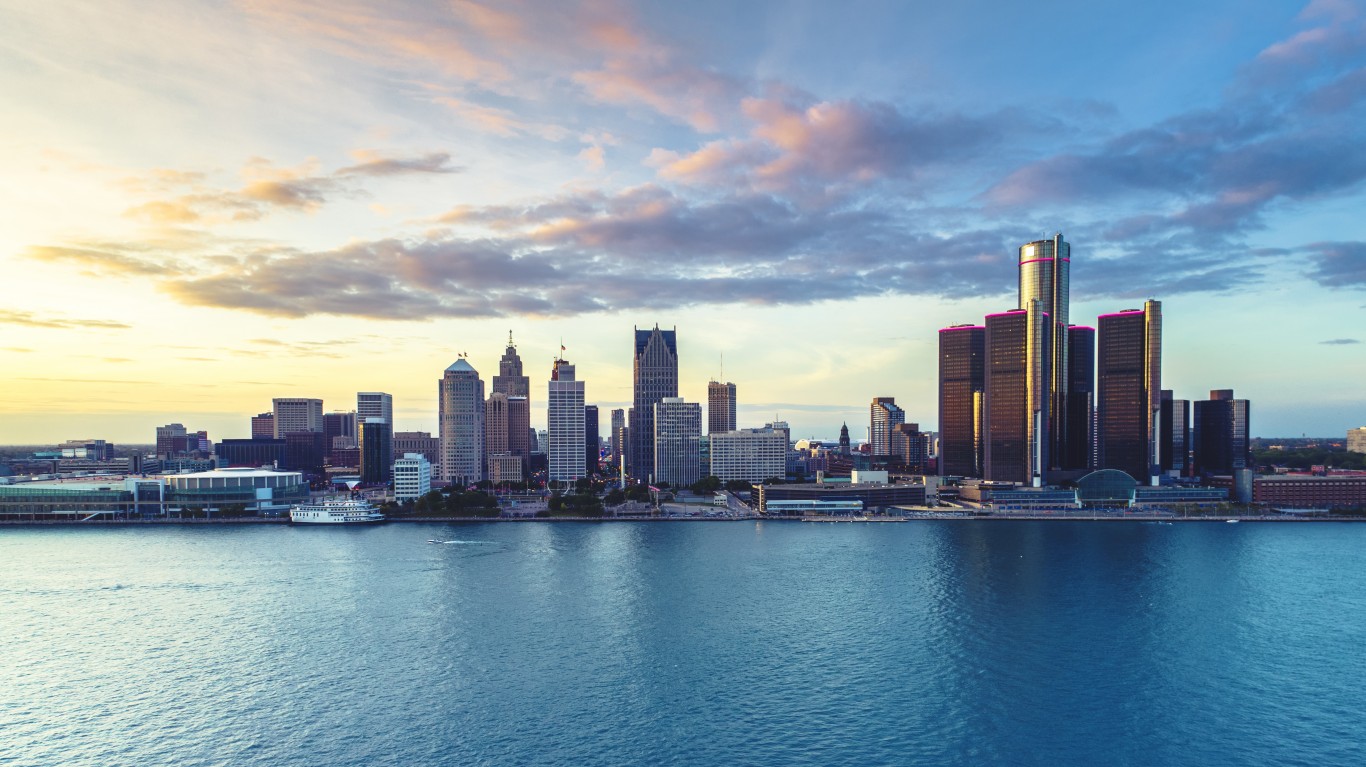
12. Detroit-Warren-Dearborn, MI
> Unemployment rate, June 2020: 17.7%
> Year-to-date employment change: -19.0%
> Cumulative COVID-19 cases to date: 51,074 (1,183 per 100,000 people)
> Poverty rate: 14.3%
> Population: 4.3 million
There are nearly 400,000 fewer people working in the Detroit metro area than there were at the beginning of the year. Mass layoffs and business closures in recent months have driven the metro area’s unemployment rate up to 17.7% from just 4.0% in January.
While Detroit’s job market ranks among the worst in the country, it has improved markedly in recent weeks. In May 2020, the area’s unemployment rate stood at 23.2%.

11. Muskegon, MI
> Unemployment rate, June 2020: 17.8%
> Year-to-date employment change: -8.0%
> Cumulative COVID-19 cases to date: 1,089 (629 per 100,000 people)
> Poverty rate: 15.8%
> Population: 173,588
The unemployment rate in Muskegon, Michigan, has improved considerably in recent months, falling from 29.8% in April to 17.8% in June. Despite the marked improvement, the metro area still has one of the worst job markets in the country.
Widespread unemployment in Muskegon is causing considerable economic harm to residents of a metro area where financial hardship was relatively common to begin with. In Muskegon, 15.8% of the population lives below the poverty line, compared to 13.1% of Americans nationwide.
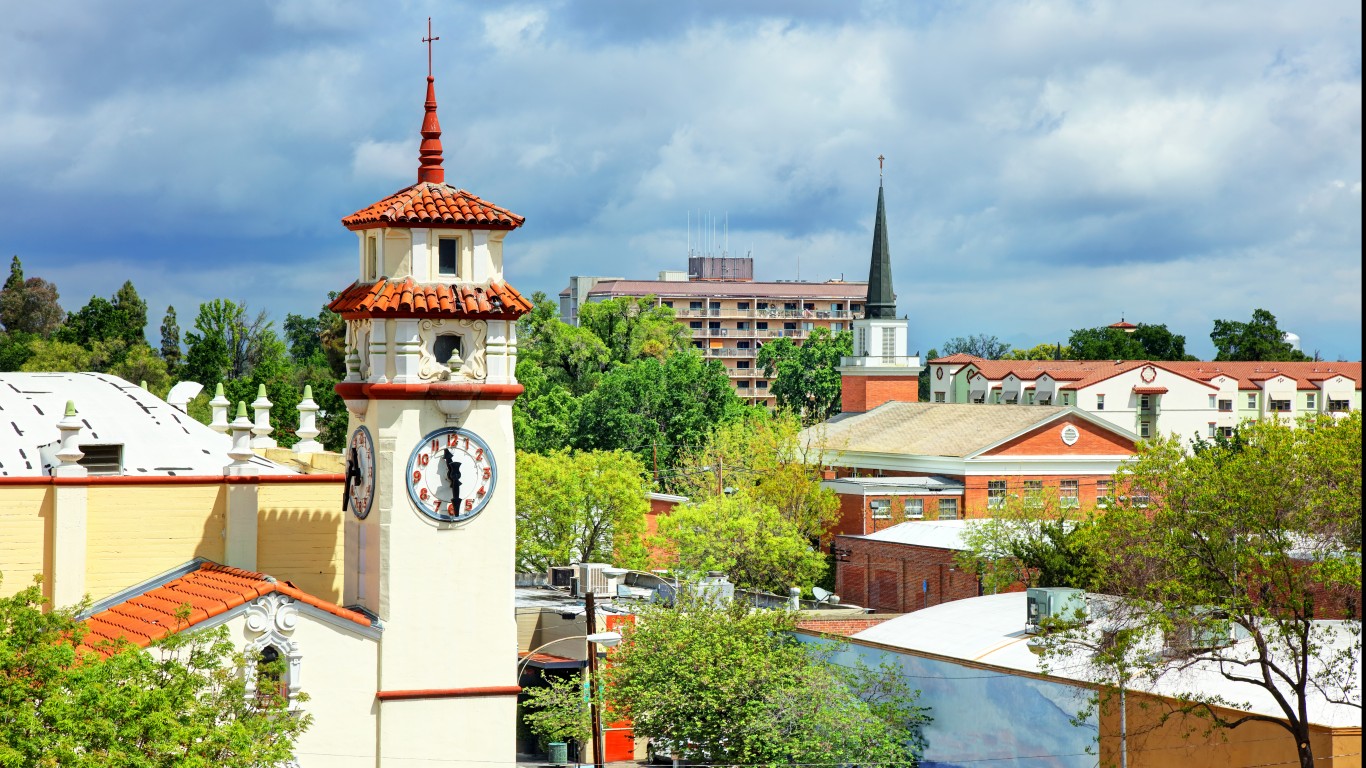
10. Visalia-Porterville, CA
> Unemployment rate, June 2020: 17.8%
> Year-to-date employment change: -14.8%
> Cumulative COVID-19 cases to date: 8,392 (1,822 per 100,000 people)
> Poverty rate: 22.5%
> Population: 465,861
The unemployment rate in the Visalia-Porterville metro area stands at 17.8%, higher than in all but a handful of other U.S. metropolitan areas. Even before the COVID-19 pandemic eliminated tens of thousands of jobs in the metro area, Visalia-Porterville was struggling with mass unemployment. In January, 9.3% of the area’s labor force was unemployed, more than double the 3.6% national jobless rate.
Generally, lower-income Americans have been at increased risk of unemployment during the COVID-19 pandemic. In Visalia-Porterville, most households earn less than $49,000 a year, while the typical American household earns about $62,000 annually.
[in-text-ad-2]

9. Pittsfield, MA
> Unemployment rate, June 2020: 17.9%
> Year-to-date employment change: -19.1%
> Cumulative COVID-19 cases to date: 645 (507 per 100,000 people)
> Poverty rate: 10.8%
> Population: 126,348
Nearly one in every five jobs that existed in Pittsfield, Massachusetts, at the beginning of the year have disappeared. Over the same period, the metro area’s unemployment rate jumped from 3.4% to 17.9%, one of the largest percentage point increases in the country. The economy across Massachusetts as a whole has been affected more than most of the country by the COVID-19 pandemic.

8. Las Vegas-Henderson-Paradise, NV
> Unemployment rate, June 2020: 17.9%
> Year-to-date employment change: -19.2%
> Cumulative COVID-19 cases to date: 37,492 (1,751 per 100,000 people)
> Poverty rate: 13.9%
> Population: 2.2 million
The COVID-19 pandemic hit the job market in the Las Vegas metro area harder than most of the country. Tourism, one of the industries most affected by the pandemic, is the backbone of the local economy. Partially as a result, since the beginning of the year, the number of people working in Las Vegas fell by nearly 20%. Over the same period, the unemployment rate spiked from just 3.8% to a staggering 17.9%.
Still, as is the case in much of the country, Las Vegas’s job market does appear to be improving. As recently as April, the unemployment rate in Las Vegas was 34.2%, making the city one of only four nationwide where more than one in every three members of the labor force were unemployed.
[in-text-ad]
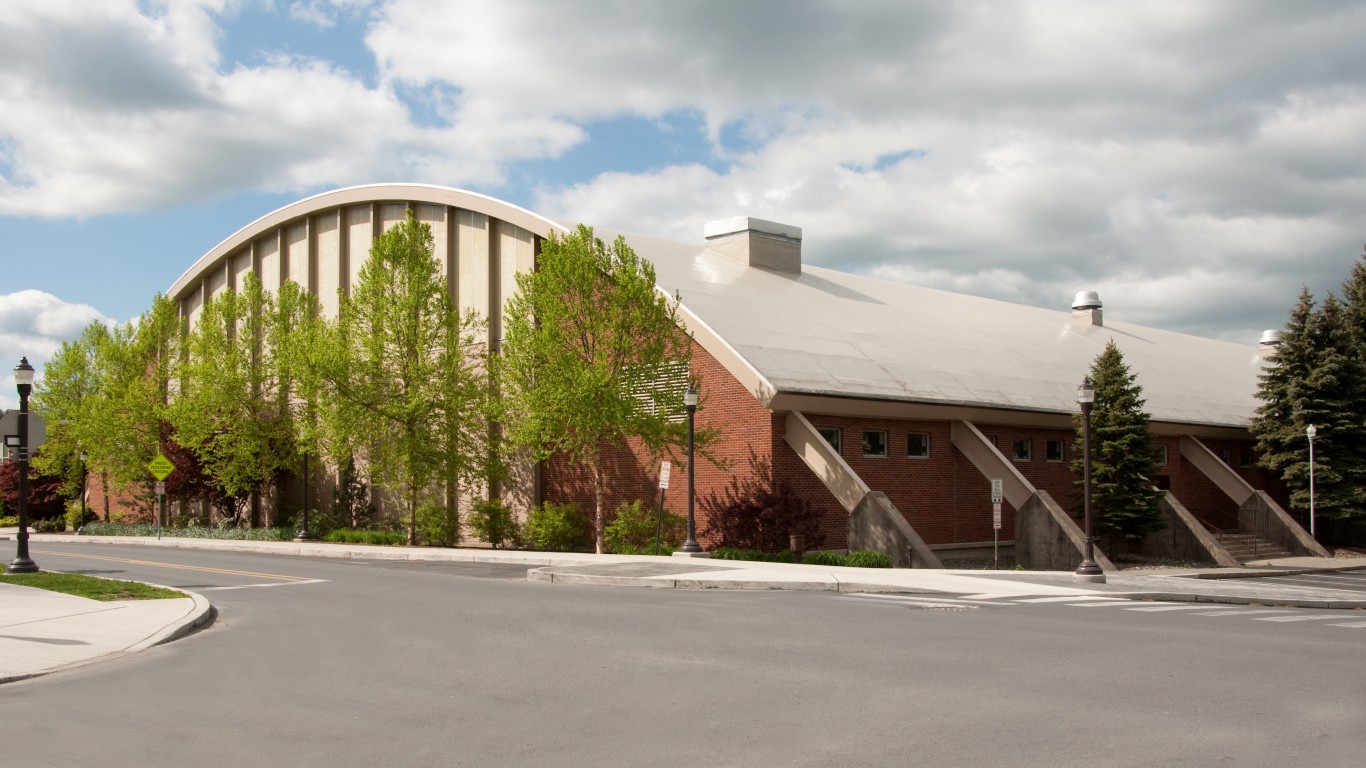
7. East Stroudsburg, PA
> Unemployment rate, June 2020: 18.0%
> Year-to-date employment change: -15.5%
> Cumulative COVID-19 cases to date: 1,557 (929 per 100,000 people)
> Poverty rate: 12.3%
> Population: 169,507
Leading up to the pandemic, more than one in every four workers in East Stroudsburg, Pennsylvania were employed in industries at high-risk of slowdown due to COVID-19, such as tourism and transportation and warehousing. Nationwide, fewer than one in five workers are employed in such industries. Due in part to the concentration of jobs exposed to the economic downturn, East Stroudsburg’s unemployment rate of 18.0% is nearly the highest of any U.S. metro area.

6. Yuma, AZ
> Unemployment rate, June 2020: 18.1%
> Year-to-date employment change: -7.4%
> Cumulative COVID-19 cases to date: 10,434 (5,020 per 100,000 people)
> Poverty rate: 19.6%
> Population: 212,128
Unlike every other city on this list, Yuma, Arizona’s unemployment problem is largely not attributable to COVID-19. At the beginning of the year, before the pandemic, the unemployment rate stood at 16.5%, higher than nearly every other metro area in the country. Though the metro area’s jobless rate hit 25.0% in April, it now stands at 18.1% — just 1.6 percentage points higher than in January. Nationwide, the unemployment rate is 7.5 percentage points higher than what it was at the beginning of the year.
While COVID-19 appears to have had a smaller than typical impact on Yuma’s economy, it has taken a considerable toll on the metro area’s public health. There have been 5,020 known cases of COVID-19 for every 100,000 people in Yuma to date, the highest concentration of any metro area in the country.
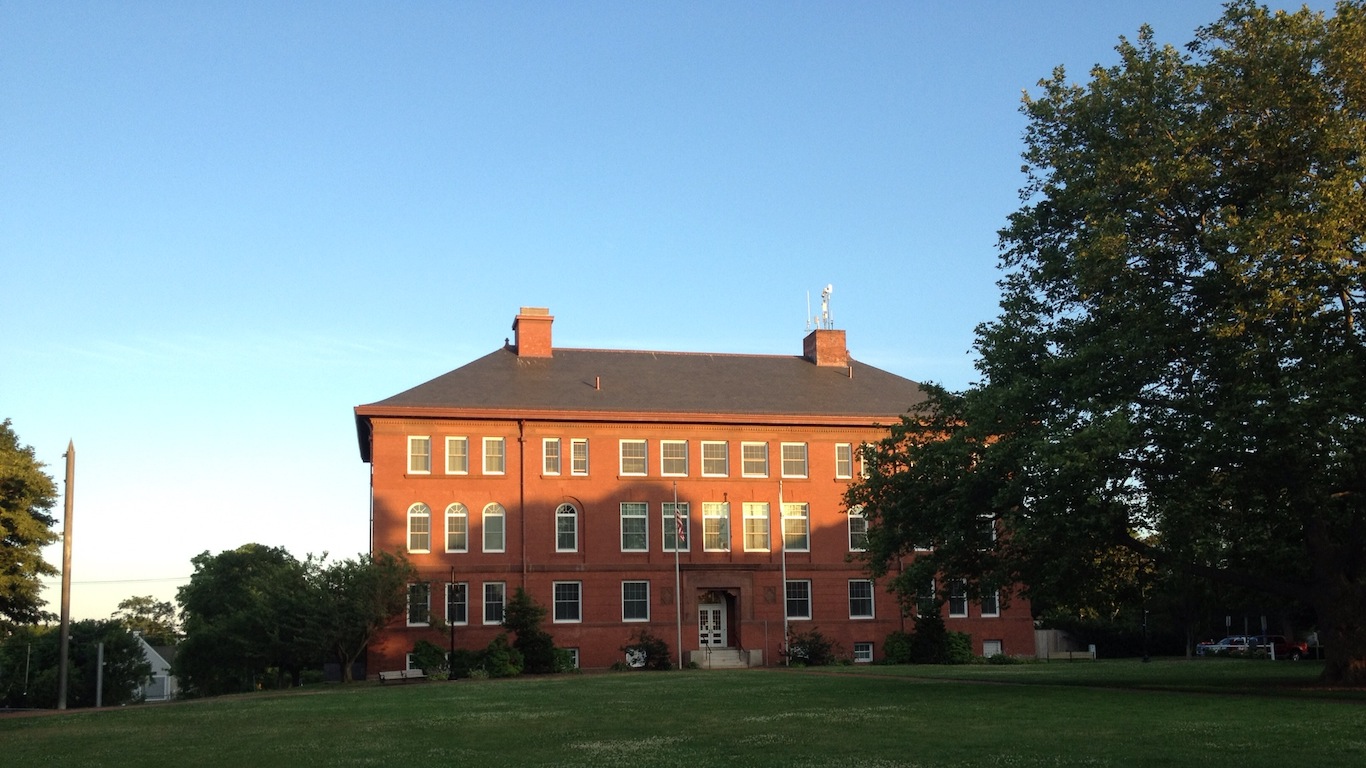
5. Barnstable Town, MA
> Unemployment rate, June 2020: 19.7%
> Year-to-date employment change: -23.6%
> Cumulative COVID-19 cases to date: 1,698 (795 per 100,000 people)
> Poverty rate: 7.6%
> Population: 213,413
In the Barnstable Town metro area, the unemployment rate stands at 19.7%, higher than every other metro area in New England and the fifth highest nationwide. Covering Cape Cod, the metro area’s economy is heavily dependent on tourism, one of the industries that has borne the brunt of the economic fallout during the COVID-19 pandemic. There are over 29,000 fewer jobs in the Cape Cod area now than there were at the beginning of the year, a 23.6% decline in employment.
[in-text-ad-2]
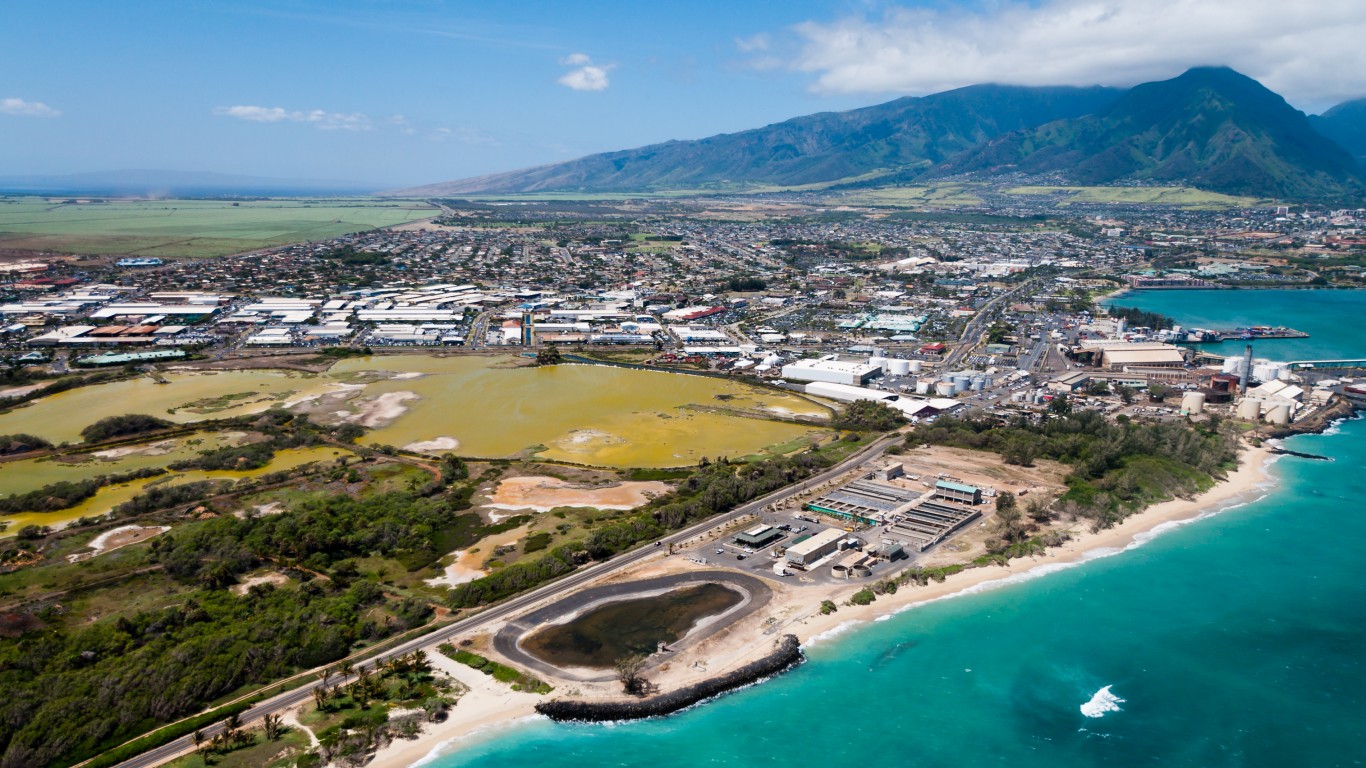
4. Kahului-Wailuku-Lahaina, HI
> Unemployment rate, June 2020: 22.3%
> Year-to-date employment change: -27.9%
> Cumulative COVID-19 cases to date: 153 (93 per 100,000 people)
> Poverty rate: 7.1%
> Population: 167,295
Few sectors of the economy have been hit as hard by the COVID-19 pandemic as tourism. For Hawaii’s Kahului-Wailuku-Lahaina metro area, where tourism is an economic backbone, overall employment has fallen by a staggering 27.9% since before the pandemic hit in January. Currently, the metro area is one of only four nationwide where more than one in every five members of the labor force are out of work.

3. Ocean City, NJ
> Unemployment rate, June 2020: 26.7%
> Year-to-date employment change: -32.7%
> Cumulative COVID-19 cases to date: 800 (854 per 100,000 people)
> Poverty rate: 9.4%
> Population: 92,560
Ocean City is one of only three metro areas nationwide where more than one in every four members of the labor force are out of work. The metro area is one several on this list that depends on tourism — an industry that has all but shut down during the COVID-19 pandemic. The number of people working in the Ocean City metro area has fallen by nearly one-third since the beginning of the year, the largest year-to-date decline in employment of any U.S. metro area.
[in-text-ad]
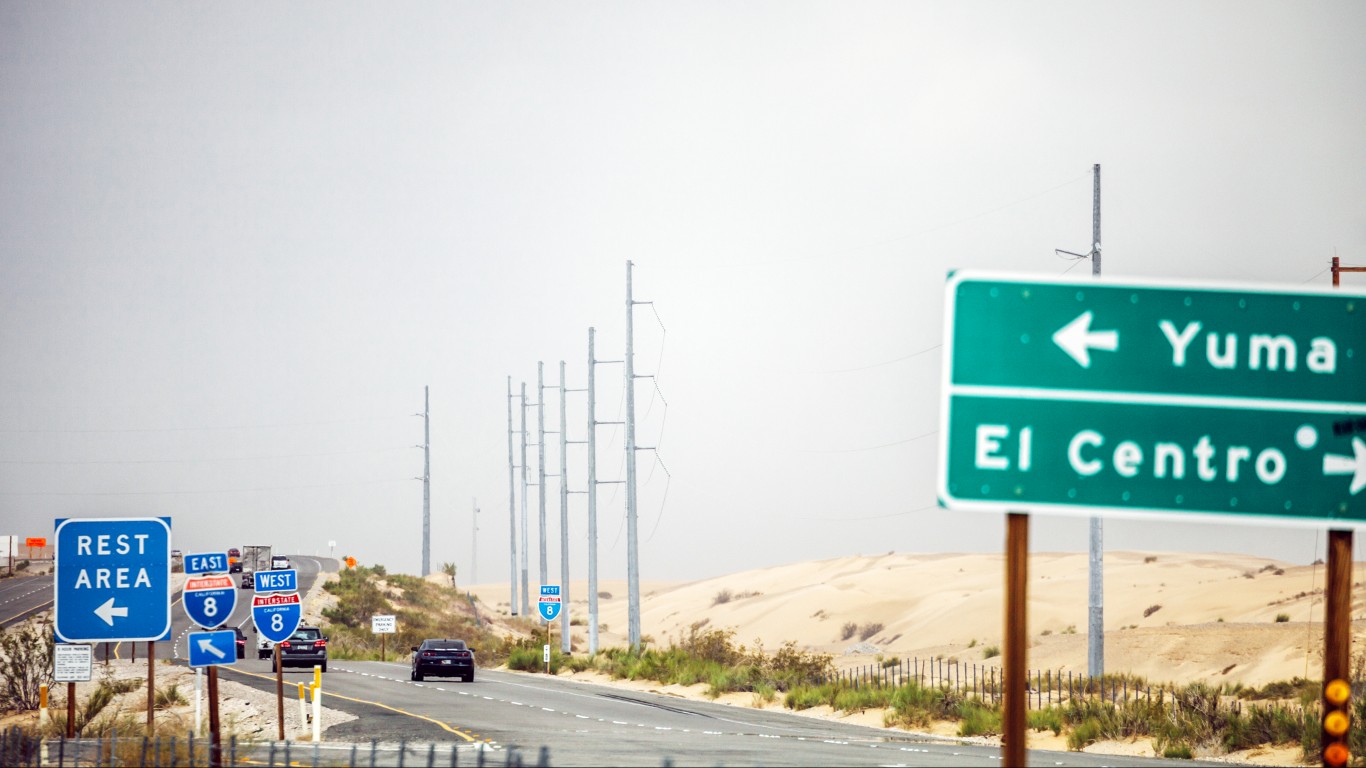
2. El Centro, CA
> Unemployment rate, June 2020: 28.7%
> Year-to-date employment change: -7.9%
> Cumulative COVID-19 cases to date: 7,781 (4,318 per 100,000 people)
> Poverty rate: 23.1%
> Population: 181,827
The unemployment rate in El Centro, California, is a staggering 28.7%, the second highest among U.S. metro areas. Though the metro area has shed thousands of jobs during the COVID-19 pandemic, it has struggled with high unemployment long before the coronavirus-induced recession. In January, El Centro’s jobless rate stood at 18.4%, higher than in every other city at the time.
In addition to weakening El Centro’s already struggling economy, the novel coronavirus has also taken a public health toll in the metro area. There have been 4,318 known cases of the virus for every 100,000 people in El Centro to date, nearly the highest concentration in the country.
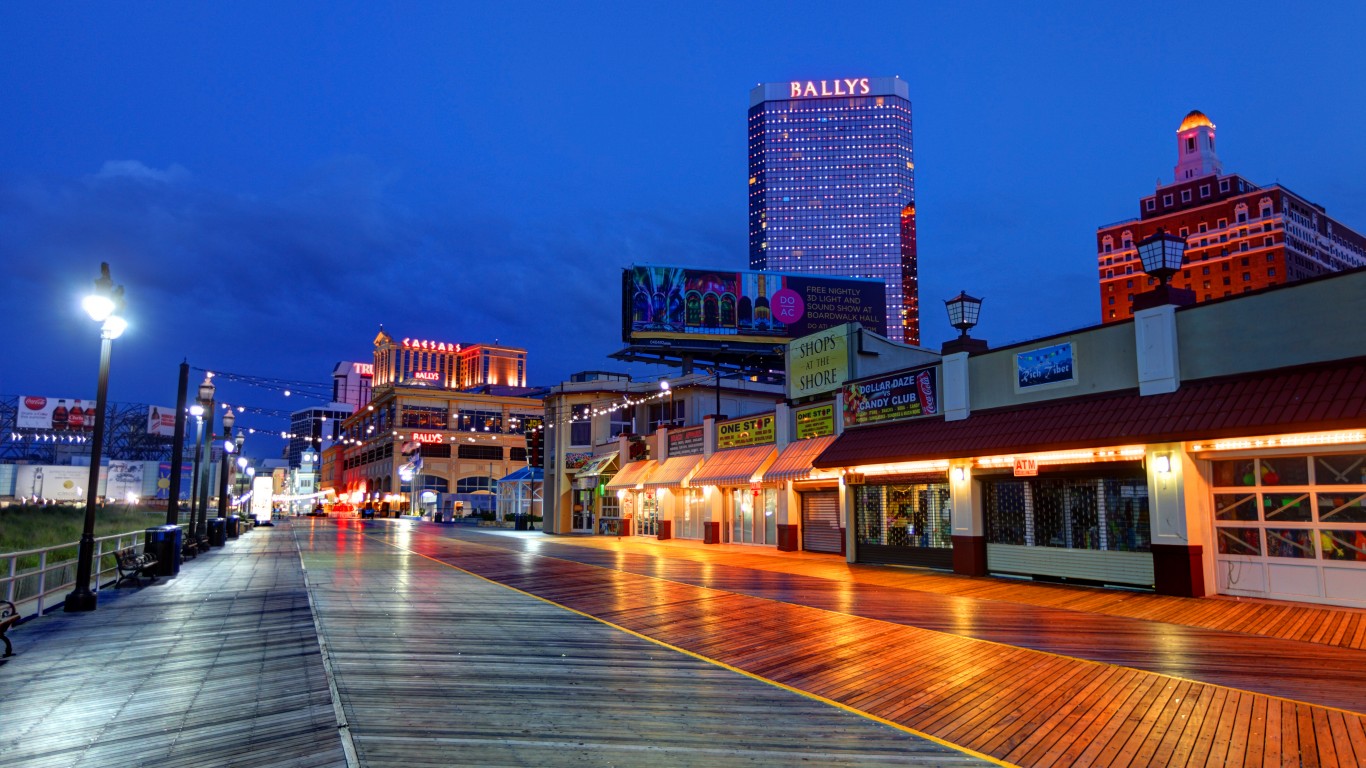
1. Atlantic City-Hammonton, NJ
> Unemployment rate, June 2020: 35.0%
> Year-to-date employment change: -27.8%
> Cumulative COVID-19 cases to date: 3,271 (1,218 per 100,000 people)
> Poverty rate: 12.9%
> Population: 265,429
Atlantic City, one of several New Jersey metro areas to rank on this list, has by far the highest unemployment rate in the United States, at 35.0% — more than triple the national jobless rate of 11.1%.
Tourism, an industry that has been all but shut down during the pandemic, is an economic pillar in Atlantic City. The leisure and hospitality sector accounts for about one-third of all jobs in the metro area. Since January, 27.8% of jobs in Atlantic City have disappeared.
Methodology
To identify the cities with the worst unemployment problem right now, 24/7 Wall St. reviewed seasonally adjusted June 2020 unemployment rates at the metropolitan area level from the Bureau of Labor Statistics. We only listed the 33 U.S. metro areas with unemployment rates above 15.0%.
In the case of a tie, the metro area that had a larger percentage decline in overall employment from January to June 2020 was ranked lower. Overall employment figures also came from the BLS.
Data on COVID-19 cases and cases per capita is current as of July 27, 2020, and came from state and local health departments.
Data on population and poverty came from the U.S. Census Bureau’s 2018 American Community Survey.
Retirement planning doesn’t have to feel overwhelming. The key is finding professional guidance—and we’ve made it easier than ever for you to connect with the right financial advisor for your unique needs.
Here’s how it works:
1️ Answer a Few Simple Questions
Tell us a bit about your goals and preferences—it only takes a few minutes!
2️ Get Your Top Advisor Matches
This tool matches you with qualified advisors who specialize in helping people like you achieve financial success.
3️ Choose Your Best Fit
Review their profiles, schedule an introductory meeting, and select the advisor who feels right for you.
Why wait? Start building the retirement you’ve always dreamed of. Click here to get started today!
Thank you for reading! Have some feedback for us?
Contact the 24/7 Wall St. editorial team.